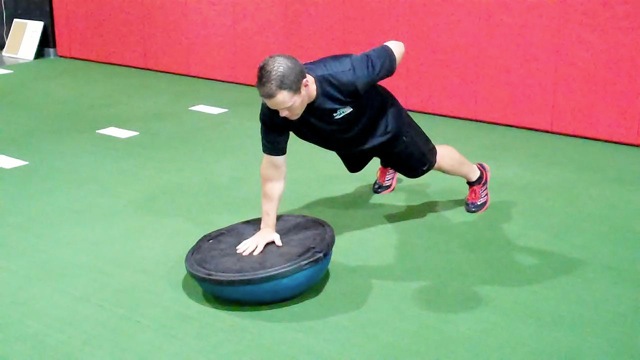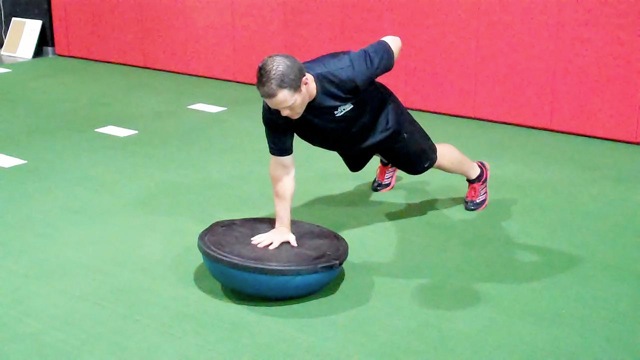
Execution:
Begin kneeling with one hand on the center of the BOSU Balance Trainer and the other hand behind the back. Next, slowly extend the knees and straighten the support elbow while keeping the body in a straight line (feet should be at least shoulder width apart.
Prior to initiating any movement with the BOSU Balance Trainer, be sure to engage the core to maintain a neutral spine angle and resist trunk rotation. Then, begin with small movements such as up/down (12 and 6 o'clock), side-to-side (9 and 3 o'clock) and eventually full circles in a clockwise and counterclockwise direction.
Perform 5-10 repetitions in each pattern or until fatigue begins to compromise form. Increasing the amplitude of the movements provides more instability and necessitates greater strength and stability throughout the whole kinetic chain.
|
Application:
Many clients are impacted by scapular winging as well as weakness in the serratus anterior and other scapular stabilizer muscles. This non-traditional exercise is very effective in reinforcing scapular stability and serratus activation. However, proper form requires good hip and core stability in order to avoid undesirable torso rotation, while challenging the muscles around the shoulder girdle to maintain proper alignment.
Regression:
Clearly, this exercise may be too advanced for some clients. Therefore, consider doing it with the knees on the ground instead of on the toes. It may be necessary to provide extra padding or cushion beneath the knees for those with arthritis or patello-femoral pain. This version may be more suitable for those with weak wrists or limited wrist mobility.
Precautions:
Clients with a history of shoulder subluxations or instability should master the quadruped rocking and tripod rocking exercises on the floor prior to initiating this activity. Appropriately choosing and progressing the load, lever arm, amplitude and volume is important. Discontinue or modify the exercise immediately in the presence of pain, instability or poor form.
In the end, the goal of the exercise is to eliminate shoulder weakness, asymmetry and dysfunction related to poor scapular stability. Utilizing the BOSU Balance Trainer allows for higher level closed-chain neuromuscular activation and greater stabilization training through the natural perturbation that occurs.
Brian Schiff, PT, CSCS, is a licensed physical therapist, respected author and fitness professional. Currently, he serves as the supervisor at the Athletic Performance Center in Raleigh, NC. Brian presents nationally at several professional conferences and seminars on injury prevention, rehab and sport-specific training. For more cutting edge training information, subscribe to his monthly Training & Sports Medicine Update at www.BrianSchiff.com.




















